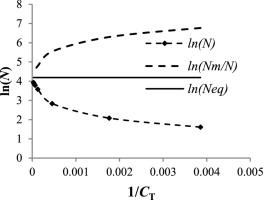Ecological Modelling ( IF 3.1 ) Pub Date : 2021-06-09 , DOI: 10.1016/j.ecolmodel.2021.109632 Mingli Chen , Zijian Wu , Xinxi Fu , Linnan Ouyang , Xiaofu Wu

|
Conducting a thermodynamic analysis of a plant community can be an approach to macro-ecology that emphasizes not only the diversity and abundances of plant species but also the exchange of matter and energy among species within the community and that with its physical and biological environment. The experimental data used for the test were obtained from an ecological restoration project implemented at a manganese tailing site. The relations derived from the maximal discrete entropy theorem show that the maximum entropy will increase with increase in the total number of species N, suggesting that N has an upper limit Nm at a habitat subject to its heterogeneity in physical conditions and species resource in its surrounding areas. As an important macroscopic property of an ecosystem, N is the number of species that are present at a habitat while its upper limit Nm is the potential number of species that have been or can be adapted to the physical conditions of the habitat, and can thus possibly be present at the habitat. As a function of the maximum entropy, ln(N) is applied as a biodiversity index. As an upper limit of ln(N), ln(Nm) can be regarded as a biodiversity potential index as it takes into account the available number of species distributed in the surrounding areas of the habitat, showing the potential limit for further increase in its biodiversity. Following the thermodynamic laws, given that there is no further change in system enthalpy H, ∆H = 0, the equilibrium number of species Neq can be found at the point ∆N = 0 and Nm can be determined by Nm = Neq2. The restoration of the investigated plant community was shown to be an irreversible process characterized by spontaneous increases in its total biomass and total number of plant species associated with increases in its enthalpy, Gibbs free energy and entropy. The analytical results gave support to the argument that the internal energy factors of a plant community are functions of its productivity and biodiversity and the difference between ln(N) and ln(Nm) determines its internal energy distribution.
中文翻译:

生态恢复植物群落的热力学分析:物种数
对植物群落进行热力学分析可以成为宏观生态学的一种方法,它不仅强调植物物种的多样性和丰度,而且强调群落内物种之间以及与其物理和生物环境之间的物质和能量交换。用于测试的实验数据来自在锰尾矿场实施的生态修复项目。由最大离散熵定理导出的关系表明,最大熵会随着物种总数N 的增加而增加,表明N有一个上限N m栖息地受其周围地区物理条件和物种资源的异质性影响。作为生态系统的一个重要宏观属性,N是栖息地存在的物种数量,其上限N m是已经或能够适应栖息地物理条件的潜在物种数量,并且可以因此可能存在于栖息地。作为最大熵的函数,ln( N ) 被用作生物多样性指数。作为 ln( N ) 的上限, ln( N m) 可被视为生物多样性潜力指数,因为它考虑了栖息地周边地区分布的可用物种数量,显示了进一步增加其生物多样性的潜在限制。遵循热力学定律,假设系统焓H没有进一步变化,Δ H = 0,可以在点 Δ N = 0处找到物种的平衡数N eq并且N m可以通过N m = N确定等式2. 研究的植物群落的恢复被证明是一个不可逆的过程,其特征是其总生物量和植物物种总数的自发增加与其焓、吉布斯自由能和熵的增加相关。分析结果给予了支持这样的论点:一个植物群落的内部能量的因素是它的生产力和生物多样性和ln之间(的差的功能Ñ)和ln(Ñ米)来确定其内部的能量分布。



























 京公网安备 11010802027423号
京公网安备 11010802027423号